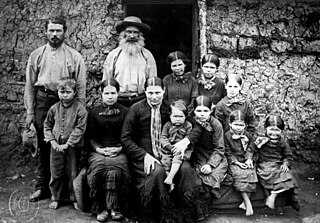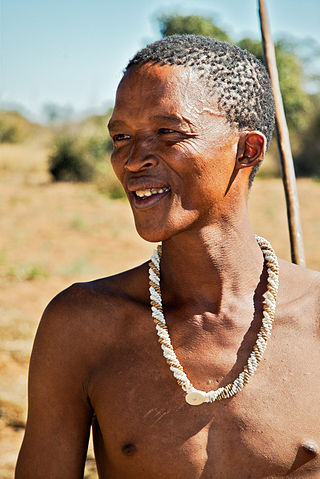Related Research Articles

Boers are the descendants of the proto Afrikaans-speaking Free Burghers of the eastern Cape frontier in Southern Africa during the 17th, 18th, and 19th centuries. From 1652 to 1795, the Dutch East India Company controlled the Dutch Cape Colony, which the United Kingdom incorporated into the British Empire in 1806. The name of the group is derived from Trekboer then later "boer", which means "farmer" in Dutch and Afrikaans.
The written history of the Cape Colony in what is now South Africa began when Portuguese navigator Bartolomeu Dias became the first modern European to round the Cape of Good Hope in 1488. In 1497, Vasco da Gama sailed along the whole coast of South Africa on his way to India, landed at St Helena Bay for 8 days, and made a detailed description of the area. The Portuguese, attracted by the riches of Asia, made no permanent settlement at the Cape Colony. However, the Dutch East India Company (VOC) settled the area as a location where vessels could restock water and provisions.

Khoisan or Khoe-Sān is a catch-all term for the indigenous peoples of Southern Africa who traditionally speak non-Bantu languages, combining the Khoekhoen and the Sān peoples. Khoisan populations traditionally speak click languages and are considered to be the historical communities throughout Southern Africa, remaining predominant until European colonisation in areas climatically unfavorable to Bantu (sorghum-based) agriculture, such as the Cape region, through to Namibia, where Khoekhoe populations of Nama and Damara people are prevalent groups, and Botswana. Considerable mingling with Bantu-speaking groups is evidenced by prevalence of click phonemes in many especially Xhosa Southern African Bantu languages.

The history of the Cape Colony from 1806 to 1870 spans the period of the history of the Cape Colony during the Cape Frontier Wars, which lasted from 1779 to 1879. The wars were fought between the European colonists and the native Xhosa who, defending their land, fought against European rule.

Khoekhoe are the traditionally nomadic pastoralist indigenous population of South Africa. They are often grouped with the hunter-gatherer San peoples. The accepted term for the two people being Khoisan. The designation "Khoekhoe" is actually a kare or praise address, not an ethnic endonym, but it has been used in the literature as an ethnic term for Khoe-speaking peoples of Southern Africa, particularly pastoralist groups, such as the Griqua, Gona, Nama, Khoemana and Damara nations. The Khoekhoe were once known as Hottentots, a term now considered offensive.

Hottentot is a term that was historically used by Europeans to refer to the Khoekhoe, the indigenous nomadic pastoralists in South Africa.

Paarl is a town with 285,574 inhabitants in the Western Cape province of South Africa. It is the largest town in the Cape Winelands. Due to the growth of the Mbekweni township, it is now a de facto urban unit with Wellington. It is situated about 60 kilometres (37 mi) northeast of Cape Town in the Western Cape Province and is known for its scenic environment and viticulture and fruit-growing heritage. Paarl is a colonial town founded by Dutch colonists who seized Khoikhoi lands, many Khoi died in the colonisation process. Paarl's colonial society was dependent on enslaved people.

The Griquas are a subgroup of mixed-race heterogeneous formerly Xiri-speaking nations in South Africa with a unique origin in the early history of the Dutch Cape Colony. Like the Boers they migrated inland from the Cape and in the 19th century established several states in what is now South Africa and Namibia. The Griqua consider themselves as being South Africa’s first multiracial nation with people descended directly from Dutch settlers in the Cape, and local peoples.

Namaqualand is an arid region of Namibia and South Africa, extending along the west coast over 1,000 km (600 mi) and covering a total area of 440,000 km2 (170,000 sq mi). It is divided by the lower course of the Orange River into two portions – Little Namaqualand to the south and Great Namaqualand to the north.

Nama are an African ethnic group of South Africa, Namibia and Botswana. They traditionally speak the Nama language of the Khoe-Kwadi language family, although many Nama also speak Afrikaans. The Nama People are the largest group of the Khoikhoi people, most of whom have disappeared as a group, except for the Namas. Many of the Nama clans live in Central Namibia and the other smaller groups live in Namaqualand, which today straddles the Namibian border with South Africa.

The side-striped jackal is a canine native to Central and Southern Africa.

Qonce, formerly King William's Town, is a town in the Eastern Cape province of South Africa along the banks of the Buffalo River. The town is about 60 kilometres (37 mi) northwest of the Indian Ocean port of East London. It has a population of around 35,000 inhabitants and forms part of the Buffalo City Metropolitan Municipality.

The Oorlam or Orlam people are a subtribe of the Nama people, largely assimilated after their migration from the Cape Colony to Namaqualand and Damaraland.

The Khoikhoi–Dutch Wars refers to a series of armed conflicts that took place in the latter half of the 17th century in what was then known as the Cape of Good Hope, in the area of present-day Cape Town, South Africa, fought primarily between Dutch colonisers, who came mostly from the Dutch Republic and the local African people, the indigenous Khoikhoi.

The Prehistory of South Africa lasts from the Middle Stone Age until the 17th century. Southern Africa was first reached by Homo sapiens before 130,000 years ago, possibly before 260,000 years ago. The region remained in the Late Stone Age until the first traces of pastoralism were introduced about 2,000 years ago. The Bantu migration reached the area now South Africa around the first decade of the 3rd century, over 1800 years ago. Early Bantu kingdoms were established in the 11th century. First European contact dates to 1488, but European colonization began in the 17th century.
Mageu, Mahewu, Mahleu, Magau (xau-Namibia), Madleke, Mabundu, maHewu, amaRhewu or amaHewu is a traditional Southern African non-alcoholic drink among many of the Chewa/Nyanja, Shona, Ndebele, Nama Khoikhoi and Damara people, Sotho people, Tswana people and Nguni people made from fermented mealie pap. Home production is still widely practised, but the drink is also available at many supermarkets, being produced at factories. Its taste is derived predominantly from the lactic acid that is produced during fermentation, but commercial mageu is often flavoured and sweetened, much in the way commercially-available yogurt is. Similar beverages are also made in other parts of Africa.

Peter Kolbe was a German teacher, astronomer, ethnologist, traveller, and explorer of South Africa. His major work was the book Caput bonae spei hodiernum (1719) in which he provided detailed descriptions of Khoikhoi life which differed significantly in perception from the descriptions of earlier travellers. He compared European culture and beliefs with those of the Khoikhoi. An English translation, by Guido Medley, was published in 1731.

Eucyon is an extinct genus of medium omnivorous coyote-like canid that first appeared in the Western United States during the late Middle Miocene 10 million years ago. It was the size of a jackal and weighed around 15kg. It was one of the few North American mammals which invaded Eurasia about 6 million years ago, followed by the genus going extinct 3 million years ago. This genus is proposed to have given rise to genus Canis 6 million years ago.

Makhanda, also spelled Makana and also known as Nxele, was a Xhosa indigenous doctor. He served as a top advisor to Chief Ndlambe. During the Xhosa Wars, on 22 April 1819, he initiated an abortive assault on the town of Grahamstown, in what was then the Cape Colony.

The Battle of Salt River was a small military engagement between the crew of a Portuguese fleet led by Francisco de Almeida and the indigenous ǃUriǁʼaekua, notable for being the first military encounter between Europeans and indigenous people in what would later become South Africa. The battle resulted in a massacre of Portuguese forces and a victory for the ǃUriǁʼaekua.